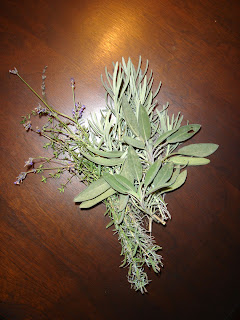
This afternoon I picked lavender, sage and rosemary from my garden...I'll use the last two for my Thanksgiving cooking and the lavender to put in vases.
A really sweet article about Victor, a 45 lb. turkey and his turkey friends eating a thanksgiving meal at Poplar Spring Animal Sanctuary. Here's an excerpt from the article:
"But before humans sit down to eat, the farm's six turkeys have their dinner. Terry Cummings, Poplar Spring's executive director, begins by introducing each one. There's Victor, of course, who has gained about 20 pounds since his Germantown adventure, along with a handful of other heritage birds. The lone white turkey, Opal, rescued from a Virginia slaughterhouse, more closely resembles the fowls that end up in your grocer's freezer. Her oversize breast and cropped toes cause her to pitch forward when she walks, and she has arthritis. But Cummings is quick to point out that, at 6 years old, she has bested the four-month life expectancy of most factory birds."
10 amazing facts about turkeys:
Turkeys recognize each other by their unique voices.
Researchers have identified more than 20 distinct vocalizations in wild turkeys.
Turkeys have excellent geography skills and can learn the specific details of an area of more than 1,000 acres.
Like cats and dogs, turkeys are intelligent and sensitive animals who form strong social bonds and show great affection to others.
On factory farms, turkeys frequently have the ends of their beaks and toes cut off without anesthesia — practices know as debeaking and detoeing — to prevent them from injuring one another as they are crowded by the thousands into dark, filthy warehouses.
Between 1965 and 2000, the weight of the average turkey raised commercially in the U.S. increased by 57 percent, from an average of 18 pounds to an average of 28.2 pounds, causing commercially-bred turkeys to suffer from crippling foot and leg problems.
Completely unlike their wild ancestors not only in terms of physique but also in hue, most commercial turkeys are totally white — the natural bronze color selectively bred out of them to eliminate uneven pigment colorations — because of consumer preference for even flesh tones.
Also catering to consumer preferences for “white meat,” the industry has selectively bred turkeys to have abnormally large breasts. This anatomical manipulation makes it difficult for male turkeys to mount the females, eliminating these birds’ ability to reproduce naturally. As a result, artificial insemination is now the sole means of reproduction on factory farms, where breeder birds are confined for months on end.
Turkeys, along with other poultry, are not protected by the federal Humane Slaughter Act, and are frequently killed without first being stunned.
Every year, more than 46 million turkeys are killed for Thanksgiving holiday dinners, but it doesn’t have to be this way. If you think these birds are as incredible as we do, you can join talk show host and animal advocate Ellen DeGeneres, Farm Sanctuary’s 2010 Adopt-A-Turkey Project spokesperson, in starting a new tradition this year by adopting a turkey instead of eating. Visit adoptaturkey.org for details or call the Turkey Adoption Hotline at 1-888-SPONSOR.
No comments:
Post a Comment